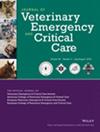Hepatic abscessation in dogs: A multicenter study of 56 cases (2010–2019)
Abstract
Objective
To investigate the clinical findings, treatment strategies, and outcomes in dogs with confirmed hepatic abscessation.
Design
Retrospective cohort study from 2010 to 2019.
Setting
Multicenter study.
Animals
Fifty-six client-owned dogs with hepatic abscessation confirmed by culture, cytology, or histopathology.
Measurements and Main Results
Dogs were presented for lethargy (39/56), hyporexia (31/56), and vomiting (26/56). Abnormal physical examination findings included increased temperature (41/56) and abdominal pain (22/54). CBCs revealed neutrophilia (31/49), toxic changes (25/49), anemia (28/49), and thrombocytopenia (23/49). Biochemical analyses revealed increased alkaline phosphatase (45/50), increased alanine aminotransferase (40/50), hypoalbuminemia (25/48), and hyperbilirubinemia (19/49). Hypoglycemia was found in 13 of 49 dogs. Hepatic abscesses ranging from 0.5 to 15 cm in diameter were identified ultrasonographically in 37 of 48 dogs; 19 of 37 had solitary abscesses, and 18 of 37 had multifocal abscessation. Escherichia coli was the most commonly cultured organism, isolated in 18 of 42 cases. Histopathology revealed underlying hepatic neoplasia in 10 of 47 dogs. Surgical management was performed in 41 of 49 dogs, and 35 of 41 survived to discharge. Medical management was performed in 8 of 49 dogs, and 5 of 8 survived to discharge. With univariate analysis, hypoglycemia and multifocal abscessation were associated with decreased odds of survival (odds ratio [OR]: 0.2, 95% confidence interval [CI]: 0.03–0.9, P = 0.04; OR: 0.07, 95% CI: 0.01–0.6, P = 0.02, respectively). With multivariate analysis, only multifocal abscessation was associated with decreased odds of survival (OR: 0.09, 95% CI: 0.01–0.87, P = 0.04).
Conclusions
Hepatic abscessation, although rare, should remain a differential diagnosis for dogs presenting with nonspecific clinical signs and increase liver enzyme activities, especially with concurrent increased temperature and neutrophilia. Rate of survival to discharge for dogs in this study was consistent with previously reported survival rates, with 40 of 56 (71%) of the total population surviving to discharge. No variables assessed were able to predict survival to discharge; however, hypoglycemia and multifocal abscessation should be assessed in larger populations to determine prognostic significance.

 求助内容:
求助内容: 应助结果提醒方式:
应助结果提醒方式:


